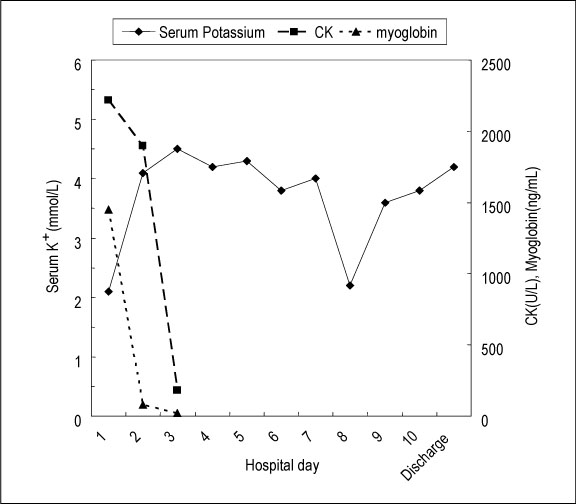J Korean Soc Endocrinol.
2005 Aug;20(4):381-384. 10.3803/jkes.2005.20.4.381.
A Case of Thyrotoxicosis Presented as Rhabdomyolysis
- Affiliations
-
- 1Department of Internal Medicine, Hanyang College of Medicine, Seoul, Korea.
- KMID: 2100469
- DOI: http://doi.org/10.3803/jkes.2005.20.4.381
Abstract
- There have been a few reports on rhabdomyolysis caused by thyroid storm, but no cases of thyrotoxicosis related rhabdomyolysis have been reported until now. Here, a rare case of rhabdomyolysis, accompanied by thyrotoxicosis, is reported. A 21-year-old man was admitted to our hospital with severe pain and weakness in both legs. The initial laboratory findings revealed a high muscle enzyme level and severe hypokalemia. In evaluation of the rhabdomyolysis, the thyroid function test was compatible with that of Graves' disease, with the rhabdomyolysis subsequently diagnosed, presenting as thyrotoxicosis. The possible mechanisms for this complaint were hypokalemia-induced muscle ischemia, a thyrotoxicosis-induced excessive hypermetabolic state and pressure-induced muscle ischemia. Therefore, the work up for the cause of rhabdomyolysis should include thyrotoxicosis. The management of rhabdomyolysis is hydration, prevention of acute renal failure, correction of aggravating factors and treatment of the underlying cause, for example, thyrotoxicosis.
MeSH Terms
Figure
Reference
-
1. Kim Moon Jae. Nontraumatic rhabdomyolysis. Korean J Med. 2004. 67:4359–4460.3. Sharma VK, Banerjee SP. beta-Adrenergic receptors in rat skeletal muscle. Effects of thyroidectomy. Biochim Biophys Acta. 1978. 539:538–542.4. Brown MJ, Brown DC, Murphy MB. Hypokalemic from beta receptor stimulation by circulating epinephrine. N Engl J Med. 1983. 309:1414–1419.5. Visweswaran P, Guntupalli J. Environmental emergencies: rhabdomyolysis. Crit Care Clin. 1999. 15:415.6. Abend WK, Tyler HR. Michael J, editor. Thyroid Disease and the Nervous System; Neurology and general medicine. Aminoff. 1995. 2nd edition. Churchill Livingstone;333–347.7. Ober KP. Thyrotoxic periodic paralysis in the United States: Report of 7 cases and review of the literature. Medicine(Baltimore). 1992. 71:109–120.8. McFadzean AJS, Yeung RTT. Periodic Paralysis Complicating Thyrotoxicosis in Chinese. Brit Med J. 1967. 1:451–455.9. Okinaka Shigeo, Shizume Kazuo, Iiro Shino, Wantanabe Akira, Irie Minoru, Nogutdchi Akito, Kuma Shizuno, Ito Tadasu. The association of periodic paralysis and hyperthyroidism in Japan. J Clin Endocrinol Metab. 1957. 17:1454–1459.10. Kilpatrick RE, Seiler-Smith S, Levine SN. Thyrotoxic hypokalemic periodic paralysis: report of four cases in black American males. Thyroid. 1994. 4:441–445.11. Hosojima H, Iwasaki R, Miyauchi E, Okada H, Morimoto S. Rhabdomyolysis accompanying thyroid crisis: an autopsy case report. Intern Med. 1992. 31:1233–1235.12. Ferreiro JE, Arguelles DJ, Rams H Jr. Thyrotoxic periodic paralysis. Am J Med. 1986. 80:146–150.14. Yeo PPB, Lee KO, Cheah JS, editors. Thyrotoxic periodic paralysis: a study of 51 patients. proceedings of the second congress of the association of southeast asian nations (ASEAN) federation of endocrine societies. 1983. 30 Nov-3 Dec; Bangkok, Thailand.15. Birkhahn RH, Gaeta TJ, Melniker L. Thyrotoxic periodic paralysis and intravenous propranolol in the emergency setting. J Emerg Med. 2000. 18:199–202.


